CIENCIAS
NUCLEARES
Use of
PIXE analysis to study urban atmospheric aerosols from downtown Havana City
Aplicación
del análisis PIXE al estudio de aerosoles atmosféricos urbanos
en el centro de Ciudad de La Habana
Grizel Pérez
Zayas1, , Ibrahin Piñera Hernández1 , Maridelin Ramos Aruca1,
Rolando Guibert Gal 1 , Enrique Molina Esquivel2, Miriam Martínez Varona2,
Ariadna Fernández Arocha2 , Francisca Aldape Ugald 3 , Javier Flores
Maldonado3
1 Departamento
de Física, Centro de Aplicaciones Tecnológicas y Desarrollo Nuclear,
La Habana, Cuba.
2 Laboratorio de Contaminantes Atmosféricos, Instituto Nacional de Higiene,
Epidemiología y Microbiología, La Habana, Cuba
3 Laboratorio de Análisis PIXE, Instituto Nacional de Investigaciones
Nucleares, México D.F., México.
ipinera@ceaden.edu.cu
ABSTRACT
The present work
shows the results of a first study aimed at determining the elemental composition
in airborne particulate matter (in fine and coarse particle size fractions).
It was collected at the Atmospheric
Monitoring Station in the Municipality of Centro Habana, using the Particle
Induced Xray Emission (PIXE) technique. At present, there is no information
available about elemental contents in airborne particulate matter from this
region. For this study, we carried out a sampling campaign during five months
(November 14, 2006 to April 19, 2007). The samples were collected every second
day during 24 h under an air flux of 20 l/min. The air sampler used was a Gent
Sampler equipped with a Stacked Filter Unit (SFU) system which allows the aerosol
collection in both size fractions simultaneously. A total of 144 aerosol samples
were collected (72 correspond to the fine mass particle and 72 to the coarse
mass particle). For PIXE analysis, the samples were irradiated by 2.0 MeV energy
protons from the 2 MV Tandetron Accelerator from the Laboratory of PIXE analysis
at ININ, Mexico. A total of 14 elements (S, Cl, K, Ca, Ti, V, Cr, Mn, Fe, Ni,
Cu, Zn, Br and Pb) were consistently detected in both of particle size fractions
with minimum detection limits in the range of 1-10 ng/ . The quantitative results obtained from PIXE elemental analysis for mass of
particles in both fractions have revealed important information that has been
used in a first attempt to understand and characterize the atmospheric pollution
in this area. A general discussion about these results is presented in this
paper.
. The quantitative results obtained from PIXE elemental analysis for mass of
particles in both fractions have revealed important information that has been
used in a first attempt to understand and characterize the atmospheric pollution
in this area. A general discussion about these results is presented in this
paper.
RESUMEN
El presente trabajo
reporta los resultados de un primer estudio realizado para determinar la composición
elemental en material particulado atmosférico (en tamaños de partícula
fina y gruesa) colectado en la Estación de Monitoreo Ambiental del Instituto
Nacional de Higiene y Epidemiología, del Municipio de Centro Habana,
utilizando la técnica PIXE (emisión de rayos X inducida por partículas).
Para este estudio se realizó una campaña de muestreo durante cinco
meses, entre los meses de noviembre, 2006 y abril, 2007, con un período
de colección de una toma cada segundo día y 24 horas de duración.
Se utilizó un muestreador de aire del tipo Gent con posibilidades de
colectar de forma simultánea el material particulado fino y grueso. Un
total de 144 muestras de MPA se colectaron para este estudio (72 de fracción
fina y 72 de fracción gruesa). Las muestras se irradiaron tras la incidencia
de un haz de protones de 2,5 MeV. Un total de 14 elementos (S, Cl, K, Ca, Ti,
V, Cr, Mn, Fe, Ni, Cu, Zn, Br y Pb) fueron consistentemente detectados en la
mayoría de las muestras, con límites mínimos de detección
entre 1-10 ng de partículas/ de aire. Los resultados del análisis PIXE para ambos tamaños de
partícula revelaron una importante información que se ha utilizado
en una primera intención para entender y caracterizar la contaminación
atmosférica del área muestreada. Se presenta una discusión
general de estos resultados en este trabajo.
de aire. Los resultados del análisis PIXE para ambos tamaños de
partícula revelaron una importante información que se ha utilizado
en una primera intención para entender y caracterizar la contaminación
atmosférica del área muestreada. Se presenta una discusión
general de estos resultados en este trabajo.
Key words:
particulates, air pollution monitoring, pixe analysis, urban areas
Introduction
Atmospheric pollution
studies in more populated cities of the world have been an important issue to
diverse authors in recent years, because of the relevant impact that pollution
has on the health of the population [1-6]. One of the most important factors
of air pollution problem in Havana City is the presence of airborne particles,
which are responsible for effects on public health, especially when their dimensions
are below 10 ìm, as they can penetrate deeply into the human respiratory
tract, reason for which studying the properties of these kind of pollutants
and its elemental characterization have become an important task to achieve.
In the frame of
an ARCAL Regional Project promoted by the IAEA, a first study of multielemental
contents in airborne particulate matter (in fine and coarse particle size fractions)
from an urban area heavily populated of the Havana City was performed using
the Particle-Induced X-ray Emission (PIXE) technique [7, 8].
PIXE is a nuclear
analytical technique that has long been applied to the study of atmospheric
aerosols and it continues as one of the most important areas of application
[9-15]. The technique has certainly contributed to the understanding of source-receptor
relationship for aerosol particles as well as to aerosol physics and chemistry.
It is a method based on charged particle accelerators, that allows fast simultaneous
analysis of all elements with atomic number larger than 13 (> Al), with a
high sensitivity (around 1 ng of an element per 1  of air), nondestructive and extremely small targets can be effectively analyzed
because of the well defined dimension of the incident proton beam on the samples.
PIXE does not offer information on chemical states of elements and it is not
applicable for lighter elements, such as C, N, H and O, which generally occupy
more than 80% of the atmospheric aerosols, but as in this type of analysis the
sample is not destroyed, PIXE aerosol analysis can be complemented with other
techniques. Examples of theme are PESA (proton elastic scattering analysis)
for measurement of hydrogen, PIGE (proton induced gamma ray emission) for detection
of light elements, like B, Li, Na, Mg, Al, Si and P and RBS (rutherford backscattering)
for measurement of C, N and O, allowing to obtain a complete reconstruction
of the aerosol mass and to achieve a more comprehensive view of the characteristic
elements of the aerosol.
of air), nondestructive and extremely small targets can be effectively analyzed
because of the well defined dimension of the incident proton beam on the samples.
PIXE does not offer information on chemical states of elements and it is not
applicable for lighter elements, such as C, N, H and O, which generally occupy
more than 80% of the atmospheric aerosols, but as in this type of analysis the
sample is not destroyed, PIXE aerosol analysis can be complemented with other
techniques. Examples of theme are PESA (proton elastic scattering analysis)
for measurement of hydrogen, PIGE (proton induced gamma ray emission) for detection
of light elements, like B, Li, Na, Mg, Al, Si and P and RBS (rutherford backscattering)
for measurement of C, N and O, allowing to obtain a complete reconstruction
of the aerosol mass and to achieve a more comprehensive view of the characteristic
elements of the aerosol.
Due to all these
advantages in order to determine elemental concentrations of a variety of airborne
pollution samples, the use of PIXE technique is recommended over other ones
that can be used too for aerosol analyses.
In the present
work, the quantitative results obtained from PIXE elemental analysis for fine
and coarse particles mass collected at the Municipality of Centro Habana, Cuba,
are presented.
Experimental
measurements
Sampling.
The sampling site (latitude 23.1N, longitude 82.4W) is located at the Air Pollutant
Monitoring Station of INHEM, in the central part of the urban area of Havana
City. This place is a heavily populated area with a great variety of industries
(factories of detergents, soft drinks, tobaccos, biological products) and a
high-traffic of vehicles. The site counts also with several sites of high humans
activity to its around, as for example: Christina’s Trains Station (1.2
km), Central Bus Station (0.81 km) visited every day by thousands commuters,
Pediatric Hospital (a few meters from it), and Unique Market (1 km). All this
together makes that this places must be observed and studied carefully for what
is a part of Havana City’s conurbation that contributes significantly to
its atmospheric pollution.
The aerosol samples
were collected during five months (from November 14, 2006 to April 19, 2007),
every second day, during 24 h (00:00 h-24:00 h) each one at an average flow
rate of 20 l/min. The sampler used in this study was a Gent Sampler with a Stacked
Filter Unit (SFU-PM10\PM2,5) system [9, 16]. This sampling device allowed the
particulate collection into two size fractions simultaneously: particles PM2,5
smaller than 2.5 µm (fine fraction) and particles PM2,5-10 with aerodynamic
diameter between 2.5 µm and 10 µm (coarse fraction). The particles
were collected on a 47 mm diameter Nucleopore polycarbonates filters; coarse
mode on filters with 8.0 µm pore size and fine particles on filters with
0.4 µm pore size. A total de 144 aerosol samples were collected (72 correspond
to the PM2,5 fine mass particle and 72 to the PM2,5-10 coarse mass particle).
The total amount
of mass deposited of fine and coarse particles on the samples were obtained
by gravimetric analysis. The filters were weighed before and after sampling
in a Cahn 33 electronic microbalance with 0.1 µg sensitivity. Before weighing,
all filters were stabilized during 48 h under constant relative humidity and
temperature conditions (45% and 22 °C). An alpha source of  was used to eliminate static charge on the samples during weighing. Measured
fine particulate matter (FPM) and coarse particulate matter (CPM) mass concentrations
(µg/
was used to eliminate static charge on the samples during weighing. Measured
fine particulate matter (FPM) and coarse particulate matter (CPM) mass concentrations
(µg/ )
are shown in figure 1. Levels of PM2,5-10 up to 44.2 µg/
)
are shown in figure 1. Levels of PM2,5-10 up to 44.2 µg/ and PM2,5 values up to 22.4 µg/
and PM2,5 values up to 22.4 µg/ were obtained.
were obtained.
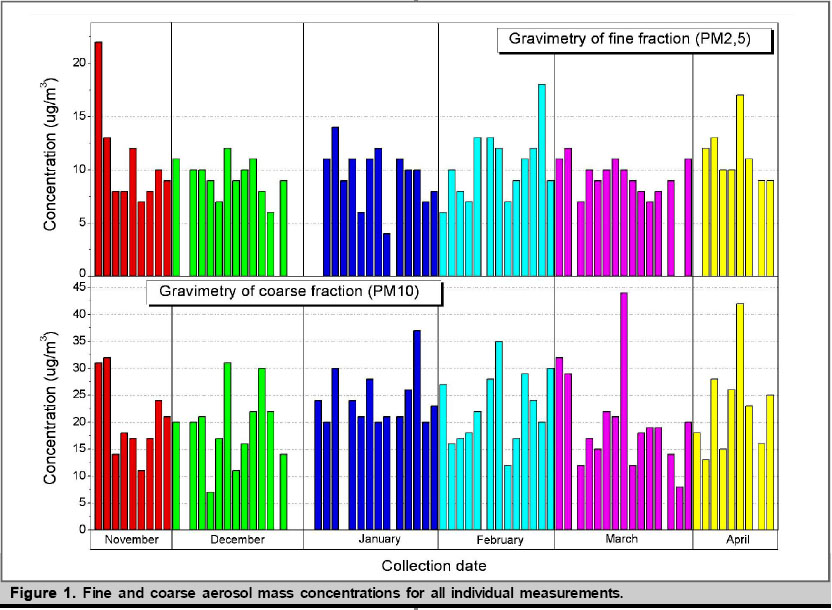
Other analyt ical
equipments operat ing simultaneously at this station provided complementary
data of several variables such as  and
and  .
.
PIXE analysis.
The experimental system of PIXE analysis consists of an accelerator, an ion
beam, a vacuum irradiation chamber with a target holder included and a measurement
system.
The aerosol samples,
without any pre-treatment, were bombarded by 2.5 MeV protons from the 2 MV Van
de Graff (Tandetron) accelerator, located at the Laboratory of PIXE Analysis
of the ININ, Mexico. Ion beam currents in the system were 15 nA and total integrated
charges were 6 µC. For the irradiation, the samples were placed in a sample
holder with an angle of 45° with respect to the beam direction. The characteristics
X-rays emitted from the samples were detected with an Ortec Si(Li) detector
with an active area of 80 mm 2 and 200 eV resolution at 5.9 keV of the Mn K
a line, coming from an 55 Fe source. The detector in the experimental arrangement
was located outside the irradiation chamber at 90° angle with respect to
the ion beam direction and is coupled to standard electronics and PC based multichannel
analyser. Spectra
were obtained in this experimental line using EG&G Ortec Maestro II computer
code [17]. The precision and reproducibility of the PIXE system were verified
on a regular basis, using spectroscopically pure thin films of known area density,
deposited on Nucleopore filters (MicroMatter Co., Deer Harbor, WA, USA). Details
of the experimental setup, instrumentation and analytical procedures used to
perform the PIXE analysis at the ININ PIXE Laboratory are better explained in
reference [18].
For the elemental
analysis the filters with the aerosol were cut in two pieces: 1/4 of it was
analysed by PIXE; the remaining 3/4 was kept for other possible measurements.
The PIXE analysis
revealed the presence of 14 elements in both particle size fractions, ranging
from sulphur (S) to lead (Pb). Irradiation time was in the interval 10-15 min.
Elemental minimum detection limits (MDL) were in the range of 0.1-10 ng/ for most of the detected elements. The precision of the elemental concentration
measurements was typical in the range of 5-10%.
for most of the detected elements. The precision of the elemental concentration
measurements was typical in the range of 5-10%.
The evaluation
of the PIXE spectra was performed with the softwares AXIL v3.0 and WinAxil v4.5.3
[19]. Two of the obtained PIXE spectra are shown in figure 2 for the airborne
particulate matter PM2,5 and in figure 3 for PM2,5-10.
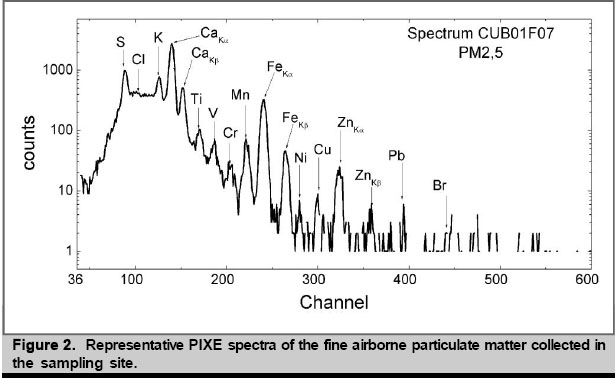
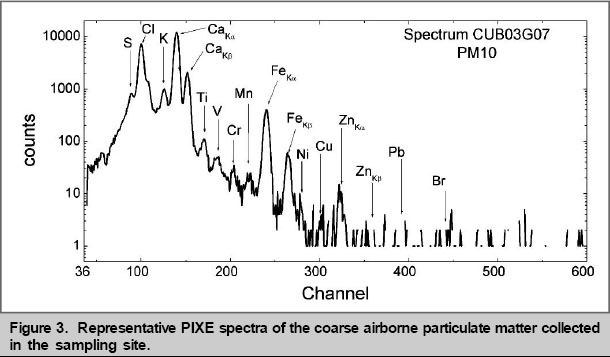
Results and
Discussion
The basis of the
present work is the elemental mass concentrations of 144 aerosol samples (fine
and coarse) analysed by PIXE. The PIXE analysis permitted to identified and
to quantify the elemental content of
the airborne particulate matter (APM) deposited on the filter and revealed consistently
the presence of the following 14 elements: S, Cl, K, Ca, Ti, V, Cr, Mn, Fe,
Ni, Cu, Zn, Br and Pb; in both particle size fractions. A summary of the elemental
concentrations for the PM2,5 and PM2,5-10 particles is presented in table 1.

The table allows
an easy comparison of the results obtained for each particle size fraction.
The information presented shows the MDL of the system for each element, the
number of appearan-ces of each element above the MDL (n) and the mini-mum, maximum,
mean and standard deviation values reached by each element. As can be seen from
the values showed in the table 1, remarkable differences are observed between
fine and coarse components.
The fine particle
fraction shows significantly higher concentrations of S, than the coarse fraction
and significantly lower values for K, Ca, Ti, while the coarse fraction has
higher contents of Cl than the fine one and soil dust related elements, such
as Ca, K, and Fe, dominate the elemental mass. Pb was found not in all samples
above the MDL, but it was found in both the fine and coarse modes in significant
quantities. Higher values of V, Cr, Ni, and Zn were observed too in the fine
fraction, bromine concentration was found apparently uniform in both fractions.
Some elements (like
S, V, Ni, Zn, Br and Pb) are considered element of anthropogenic origin and
are present mainly in the fine fraction. Other elements (like K, Ca, Ti, Fe,
and Cl) are considered element of natural
origin and appeared mainly in the coarse fraction. These tendencies correspond
to the chemical characteristics of atmospheric aerosols [20].
According to the
sampling site, the elements detected in these particles by the PIXE analysis
can be associated to diverse emission sources, such are the cases of S, V and
Pb, representing the fossil fuel combustion group from industrial and motor
vehicles. The metal group formed by Cr, Mn, Ni, Cu and Zn can be associated
to metallurgic industry and K, Ca, Ti and Fe are soil derived elements or road
dust related elements. Our sampling site is located nearby important roads of
the city. We assumed that the Cl found in coarse fraction is coming from the
marine aerosol, but it should be careful treated, because the Na is an important
component of that source and in our case it was not detected in the elemental
composition of aerosol samples by this technique, due to specific limitations
related with the used PIXE installation at ININ. The mean total seawater ratios
for Cl/Na are well known [21], then, is our great interest to know the Na content
in our samples, for what we need to analyze them by another technique that ensure
the detection and quantiûcation of this element. Some work is in progress
in this direction. In some articles in the literature Br is reported as a vehicular
component [22] and in other studies appeared associated to the incineration
of certain materials [23].
Sulphate particle
is an important component of the aerosol in this area, mainly originating from
gas to particle conversion from  . S is considered an anthropogenic element, which is most likely present in
the fine aerosol. Sulphur was present in all samples in concentrations ranging
from 121 ng/
. S is considered an anthropogenic element, which is most likely present in
the fine aerosol. Sulphur was present in all samples in concentrations ranging
from 121 ng/ to 1712 ng/
to 1712 ng/ of air sampled, however appeared significantly higher in the fine fraction of
aerosol.
of air sampled, however appeared significantly higher in the fine fraction of
aerosol.
The elemental concentrations
determined by the PIXE analysis were used to analyse the temporal variations
of each element. The concentrations in the complete collection period are shown
in figure 4 for S in fine mode and in figure 5 for Cl in coarse one.
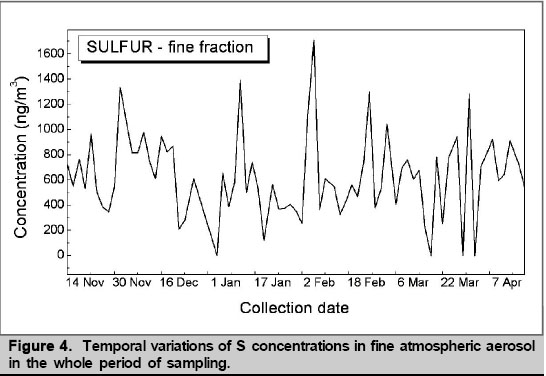
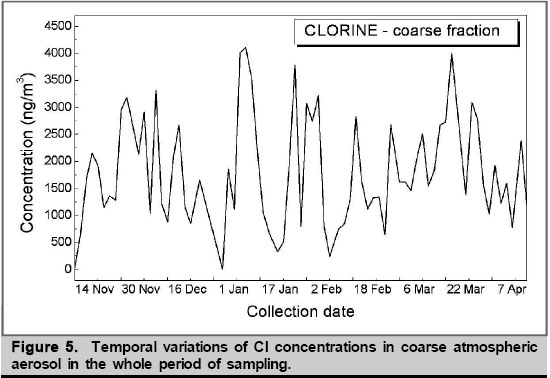
In the temporal
variation of the PM2,5 and PM2,5-10 mass concentrations showed in figure 1,
the peaks of particulate concentrations coinciding with the periods of changes
in the weather conditions, when dispersion of the contaminants is more difficult,
i.e. entrance of a cold front with temperature decreasing and high pressure.
High concentration for some elements, as the S in fine mode and Cl in coarse
mode were also observed in these days (see figure 4 and figure 5).
Conclusions
The results obtained
in this work represent a first effort to evaluate the elemental composition
in the airborne particulate matter (fine and coarse) in an urban area, heavily
populated, of the Havana City with the use of nuclear analytical techniques.
A total of 144
aerosol samples were collected (72 correspond to the fine mass fraction and
72 to the coarse mass fraction). PIXE analysis revealed the detection of 14
elements (S, Cl, K, Ca, Ti, V, Cr, Mn, Fe, Ni, Cu, Zn, Br and Pb) in both particle
size fractions.
Toxic elements
(like S, V, Ni, Zn, Br and Pb) were observed with higher concentrations in the
PM2,5 fine mode and are mainly considered element of anthropogenic origin, aspect
that should be considered in the impact and health studies that are carried
out in this place. Those elements that are considered from natural origin (like
K, Ca, Ti, Fe, and Cl) appeared mainly in the coarse fraction.
PIXE has showed
that is a suitable technique for the analysis of atmospheric aerosol and particularly
for the fast and routine analysis of aerosol particulates collected on filters.
It is a technique highly sensitive and multielemental, no sample preparations
is required, analyses can be automated and carried out in few minutes, the low
detection limits allow particle fractions to be observed and the sample is not
destroyed, allowing further characterization using other techniques in the same
filter. By means of PIXE, it is possible to measure a sample of few micrograms
in a few minutes reaching MDL’s in the order of ng/m 3 for most of the
elements (Z>11).
These results obtained
by the PIXE analysis have revealed important informat ion about elemental composition
of airborne particulate matter PM2,5 and PM2,5-10 from sampled area, and especially
about the inhalable fine fraction, from which didn’t exist any information.
It is important to notice that with this technique was possible to measure significant
elements in environmental and health related studies like S and Pb, which are
difficult to detect and evaluate using other techniques.
Furthermore, the
elemental database obtained from the PIXE analysis combined with gas measurements
and statistical analysis will allow extracting a first idea of the pollution
sources of the area under study, but much more work is required. It is necessary
to get much more information, for example, if it is possible to sampling over
a longer time (1 year), giving the possibility of study the elemental seasonal
variations in a whole year, also to be able to correlate those profiles with
meteorological varia-bles and with larger amounts of samples get better statistically
results.Furthermore, the analysis can be complemented on the same samples with
other physics and chemical analytical techniques, as the ion beam analysis techniques
for detection of light elements, ion chromatography for cation ( ,
,  ,
,
 ,
,  )
and anion (
)
and anion ( ,
,
 ,
,
 )
species, reflectance technique for black carbon concentration, and gas chromatography
– mass spectrometer for organic compound characterization.
)
species, reflectance technique for black carbon concentration, and gas chromatography
– mass spectrometer for organic compound characterization.
All this will allow
obtaining a complete scheme about atmospheric pollution in the area, allowing
to understand how it is affecting life of people in the cities densely populated
and in order to establish air pollution control and reduction programs.
Acknowledgements
This work has been
financially supported by the International Atomic Energy Agency (IAEA) under
the Regional Project ARCAL RLA7011. We are deeply grateful to F. Aldape and
J. Flores, from PIXE Laboratory at the ININ-Mexico, for their kind collaboration.
We also appreciate the technical support and assistance provided by the technical
staff of that Laboratory during gravimetric, irradiation and PIXE analysis of
the samples.
References
[1] NEL A. Air
Pollution-Related Illness: Effects of Particles. Science. 2005; 308(5723): 804-806.
[2] O'NEIL MS, LOOMIS D, TORRES-MEZA V, et. al. Estimating particle exposure
in the Mexico City metropolitan area. Journal of Exposure Analysis and Environmental
Epidemiology. 2002; 12(2): 145-156.
[3] ALDAPE F, FLORES MJ, FLORES AJ, et. al. Elemental Composition and Source
Identification of PM 2,5 particles collected in downtown Mexico City. International
Journal of PIXE. 2005; 15(3-4): 263-270.
[4] ARTAXO P, GERAB F, RABELLO MLC. Elemental composition of aerosol particles
from two atmospheric monitoring stations in the Amazon Basin. Nucl. Instr. Meth.
B. 1993; 75(1-4): 277-281.
[5] ALVES LC, REIS MA, FREITAS MC. Air particulate matter characterization of
a rural area in Portugal. Nucl. Instr. Meth. B. 1998; 136(1-4): 941-947.
[6] BRAGA CF, TEIXEIRA EC, MEIRA L, et. al. Elemental composition of PM 10 and
PM 2.5 in urban environment in South Brazil. Atmospheric Environment. 2005;
39(10): 1801-1815.
[7] JOHANSSON SAE, CAMPBELL JL. PIXE: a novel technique for elemental analysis.
Chichester: John Wiley & Sons, 1988.
[8] MAENHAUT W, MALMQVIST KG. Particle-Induced X-ray Emission Analysis. In:
Handbook of X-Ray Spectrometry. Second Edition. New York: 2002. p 719-809.
[9] MAENHAUT W, FRANÇOIS F, CAFMEYER J. The ''Gent'' stacked filter unit
(SFU) sampler for the collection of atmospheric aerosols in two size fractions:
Description and instructions for installation and use. IAEA Report NAHRES-19.
In: Applied Research on Air Pollution using Nuclear-Related Analytical Techniques.
Vienna: IAEA, 1994. p. 249-263.
[10]ALDAPE F. Uso de los Aceleradores en la Búsqueda de Soluciones a
la Problemática Ambiental: Trascendencia Social. In: Experiencia Mexicana
en Aceleradores de Partículas. Serie: CIENCIA Y TECNOLOGÍA EN
LA HISTORIA DE MEXICO. Editorial Siglo XXI, 2004. Primera Edición. p.
203.
[11]ALDAPE F, FLORES MJ, DÍAZ RV, et. al. Upgrading of the PIXE system
at ININ (Mexico) and report on elemental composition of atmospheric aerosols
from 1990 in the ZMCM. Nucl. Instr. Meth. B. 1996; 109: 459-464.
[12]ALDAPE F, FLORES MJ, GARCÍA R, et. al. PIXE analysis of atmospheric
aerosols from a simultaneous three site sampling during the autumn of 1993 in
Mexico City. Nucl. Instr. Meth. B. 1996; 109: 502-505.
[13]FLORES MJ, ALDAPE F. PIXE study of airborne particulate matter in northern
Mexico City. International Journal of PIXE. 2001; 11(1-2): 61-67.
[14]MIRANDA J, LÓPEZ SUÁREZ A , PAREDES GUTIÉRREZ R, et.
al. A study of atmospheric aerosols from five sites in Mexico city using PIXE.
Nucl. Instr. Meth. B. 1998; 136(1-4): 970-974.
[15]FLORES MJ, ALDAPE F, DÍAZ RV, et. al. PIXE analysis of airborne particulate
matter from Xalostoc, Mexico: winter to summer comparison. Nucl. Instr. Meth.
B. 1999; 150(1-4): 445-449.
[16]HOPKE PK, XIE Y, RAUNEMAA T, et. al. Characterization of the Gent Stacked
Filter Unit PM 10 Sampler. Aerosol Science and Technology. 1997; 27(6): 726-735.
[17]EG&G ORTEC Maestro II Emulation Software [software informático].
V.1.10. Oak Ridge, 1990.
[18]FLORES MJ, ALDAPE F, DÍAZ RV, et. al. Set-up and improvements of
the PIXE facility at ININ, Mexico. Nucl. Instr. Meth. B. 1993; 75(1-4): 116-119.
[19]AXIL. Quantitative X-ray Analysis System. [software informático].
V.3.3 and WinAxil V.4.5.3. Developed under the auspices of the International
Atomic Energy Agency (IAEA). Vienna, Austria.
[20] KASAHARA M. Characterization of atmospheric aerosols and aerosol studies
applying PIXE analysis. In: Analytical Chemistry of Aerosols. CRC Press LLC,
2001. p. 145-171.
[21]WEAST RC. CRC Handbook of Chemistry and Physics : A Ready-Reference Book
of Chemical and Physical Data. 57th ed. Cleveland: CRC Press, 1977. p. 203.
[22]THURSTON GD, SPENGLER JD. A quantitative assessment of source contributions
to inhalable particulate matter pollution in metropolitan Boston. Atmospheric
Environment. 1985; 19(1): 9-25.
[23]GREENBERG RR, GORDON GE, ZOLLER WH, et. al. Composition of particles from
the Nicosia Municipal Incinerator. Environ Science and Technol. 1978; 12(12):
1329-1332.
Recibido: 14 de
octubre de 2009
Aceptado: 12 de noviembre de 2009